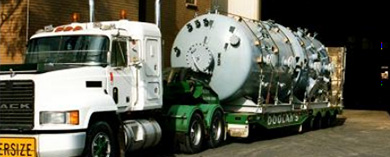
- (03) 5909 8218
- enquiry@fusionweld.com.au
Fabricating Low Pressure Separator vessels
October 8, 2014

While the label reads as self-explanatory, it's worth taking the time to properly delineate the function of these vessels. Separators divide substances into different states. Using the oil and gas industry as an example, the low-pressure variant involves fabricating vessels to separate liquid and gas at a stated low pressure. Pulling back to see the entire process, onshore piping takes fluids and gases through several other stages, including primary phase separation and high-pressure separation, but the model of operation is designed to act as a stepping process, reducing the energy of a well stream through intelligently positioned separator apparatus.
The fabrication criteria assigned to sizing a separator vessel is contingent on pressure carrying capacity. This same guideline affects the selection of the graded steel or other metal used in the manufacturing process. In this case, the low pressure characteristics of the design indicate a large volume, a deduction taken from the lack of compressed liquid or gas in the current stage of the process. More pressure would typically equal less volume and greater energy, leading to a smaller tank and a higher working pressure specification in the design construction blueprints. The separator designation also indicates a multi-stage dynamic. The standard stages fall almost wholly within the two-stage area, but three stage options exist. A two-stage tank would separate liquid from gas while the third stage acts to isolate free water from the setup.
The actual shape of the vessel can be seen in many forms. Horizontal and vertical designs are both common. The form descends more from manufacturer preference than any engineering requirement. As long as the separator vessel has an internal spherical shape, the physical composition of the gas and liquid will dictate the separation process. The separation action itself is performed by gravity, but many separation aids are added to the design of the vessel to cope with the properties of liquids and gases. For example, a hydrocarbon cycle positions low pressure vessels close to the wellhead to isolate different densities, the liquid flow of oil and the free-floating natural gas for further compression and piping to a storage facility. The aforementioned separation methodology is a science unto itself. Gravity is the first force to be employed, and this aligns with coalescing, centrifugal action, heat, and many other separation techniques that must be incorporated into the design for the vessel.
The general pressure capacity of this class of separation vessel falls within the 10 to 225 psi range, but other stages can handle compressed fluids and gases within an operational spectrum of 4000 to 5000 psi. Other specifications critical in the design of the vessel include a volumetric overhead to allow droplets to settle without flooding mist extractors, the provision of pneumatic, electrical, or mechanical control systems to monitor pressure and temperature, and coalescing assemblies to finitely isolate one state of the substance from the other. These factors will depend on the position of the vessel in the production line, with a final stage requiring absolute separation before sale.
Contact Details
Fusion - Weld Engineering Pty Ltd
ABN 98 068 987619
1865 Frankston Flinders Road,
Hastings, VIC 3915
Ph: (03) 5909 8218
Optimized by NetwizardSEO.com.au
Recent Posts
- Compressed Hydrogen Storage Vessels: Material Selection, Design & Australian Standards
- Welding QA/QC in Oil & Gas Pressure Vessel Fabrication – Ensuring Code Compliance
- AS1210 vs ASME VIII Pressure Vessel Code: Key Differences for Australian Projects
- Mitigating Hydrogen-Induced Cracking in Pressure Vessels: Engineering and Material Strategies
- Storage Tank Solutions Australia: Field-Erected, Prefabricated & Self-Bunded Explained
- Reducing Environmental Risks: Self-Bunded Tanks in Australian Oil & Gas Operations
- Precision in Production: How Pressure Vessels Are Manufactured for Industrial Safety
- Shell & Tube Heat Exchangers: Improve Thermal Control & Energy Recovery in Petrochemical & Pharmaceutical Plants
- In-Service Inspection for Compressed Air Receivers for Power Plant Shutdown Prevention
- Power Plant Pipe Spooling Fabrication – Get Rapid, Code-Compliant Spools Ready for Installation
- Field Erected Tanks: Safe, Reliable On-Site Fuel Storage Solutions in Australia
- Custom Pressure Vessel Fabrication for Flammable Gases
Posts 2025
- Compressed Hydrogen Storage Vessels: Material Selection, Design & Australian Standards
- Welding QA/QC in Oil & Gas Pressure Vessel Fabrication – Ensuring Code Compliance
- View all articles…
Posts 2024
- Large Process Vessels: Optimising the Design for Maximum Efficiency [2025]
- Pressure Equipment Management System Installation: Detect Equipment Faults Early
- View all articles…
Posts 2023
- Pressure Piping System Inspection: A Gift of Safety for the Holidays
- Deaerator Inspections by Fusion-Weld Engineering and How They Reduce System Downtime
- View all articles…
Posts 2022
- How Fusion Weld Keeps Up With AS-NZS ISO 9001:2008 Standard
- Boiler Equipment Safety Inspection During the Summer Season
- View all articles…
Posts 2021
- Avoid These Factors and Practices that Contribute to Sealing Damage in Pressure Vessels
- Do's And Don'ts Of Industrial Boiler Inspection And Maintenance From Fusion-Weld
- View all articles…
Posts 2020
- What are the Risks and Hazards Involved in Pressure Vessel Equipment?
- How to Know if Your Pressure Equipment Needs Repair or Replacement?
- View all articles…
Posts 2019
- Factors that Contribute to Pressure Vessel Failure
- Pressure Vessel Regulations in Australia: What are the Mandatory Requirements?
- View all articles…
Posts 2018
- Pros and Cons of Spherical vs. Cylindrical Pressure Vessels
- What are the Different Hazard Levels in Pressure Vessels?
- View all articles…
Posts 2017
- Transportable Pressure Vessels: The Importance of Inspection and Safety Checks
- Fracture Mechanics and Stress Analysis of Cracks in Pressure Vessels
- View all articles…
Posts 2016
Posts 2015
- What Are Deaerators & Feedwater Vessels?
- Precautions and Safety for Compressed Air Receiver Vessels
- View all articles…
Posts 2014
- Demonstrating In-process Inspection Procedures
- Static Grounding Practices and Standards
- View all articles…